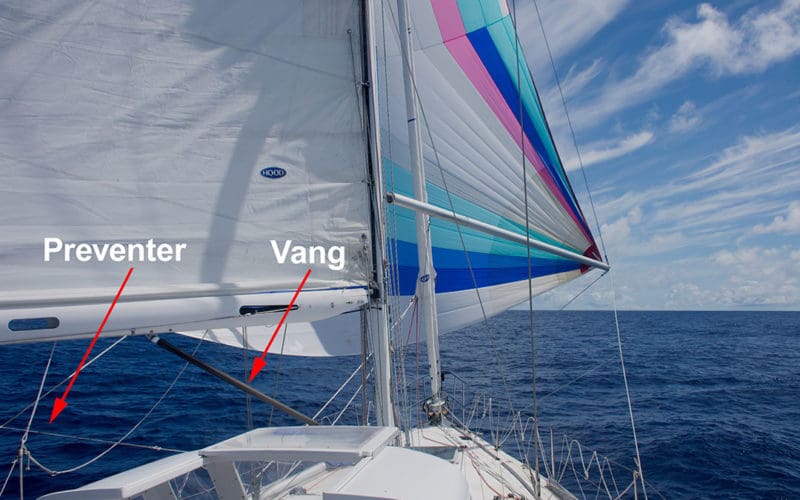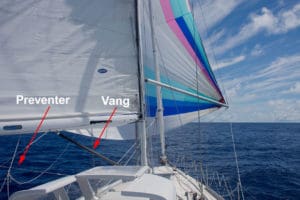
Downwind sailing in the Tradewinds can be delightful with the following swell rolling by and the bow aimed at a distant destination. It can also be entirely unpleasant when the apparent wind becomes so light that the mainsail flops around as the boat rolls heavily, causing the boom to slam about the rig. When that happens there are two choices — 1) alter course to increase apparent wind and reduce roll or 2) adjust the boom’s rigging to hold it stable.
I’ve observed sailors trundling along offshore with their booms flailing side-to-side across the boat, flipping the mainsail so high that it catches the upper spreaders and tears. Also broken are goose necks, travelers, vangs, and booms themselves. There’s no need for damage if the boom is rigged for positional control; it’s less wear on the boat and safer for the sailor.
Forces acting on the boom are readily apparent. The mainsail clew lifts up and pulls forward, rigging on the boom works to hold the boom down and aft. With the boom eased beyond the traveler the mainsheet pulls aft, down, and compresses the boom. The vang pulls down and compresses the boom. The topping lift pulls up (or rigid vang pushes up) and compresses the boom. The preventer pulls forward, down, and compresses the boom. Notice something? Every control line is adding compression to the boom, and all that force is driven into the gooseneck. The only thing resisting the compression force is the mast section.
In stable conditions sails remain filled, loads are static, and the system is in equilibrium. With a full mainsail the boom is held out by the wind’s pressure in the sail, even as the boat rolls in the prevailing swell.
In light wind conditions the swell will continue to roll the boat but the swing of the mast through the air creates a lateral apparent wind that causes the mainsail to flop from full to luffing (or inverted) and back to full. Each time the main goes full there’s a resounding BANG and a shock load is generated along the leech. The shock load hits the boom vertically at the clew and the rigging must absorb that load. The vang translates the force into a downward bending moment on the boom and a forward compression into the gooseneck. This is a great way to break the gooseneck, the vang, or the boom. If you want a real eye-opener experience, lay down on the deck under the boom and sight up the mast to see what’s happening to the mast tube each time the mainsail flaps: the mast briefly goes noticeably out of column and then snaps back to vertical. Ouch!
Rigging the boom: How to prevent (or minimize) shock loads? Use the boom’s control lines along with one or two extras that can be added: a preventer to the bow, and an adjustable clew-vang strap (my name for this piece of gear) to the rail. The rigging makes controlling the boom straight forward.
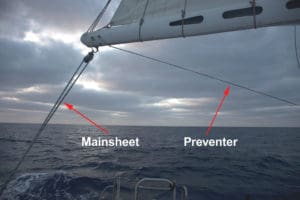
Mainsheet: The mainsheet controls how far outboard the boom is allowed to pivot from centerline. Ideally the mainsheet is attached at the outboard end of the boom right where the mainsail clew is positioned. A mid-boom sheeting arrangement pulls down at the middle of the boom, creating a continual attempt to bend the boom in half. A boom rigged this way needs to be exceptionally strong not to bend. Placing the sheet aft significantly reduces bending loads on the boom.
Vang: The vang supplies all the downward force when the boom is eased beyond the traveler, counteracting the mainsail trying to lift the boom. The vang attachment point at the boom is a critical failure point, especially as the vang attachment is (usually) not at all close to the sail clew attachment point. Often booms break or fold at the vang bracket. Before heading offshore ensure that the boom is strong enough to handle the vang loads for days on end.
Topping lift (or rigid vang): The topping lift holds up the weight of the boom (same is true for the return-force supplied by a rigid vang’s internal spring or air pressure cylinder), which allows an open leech — and you want an open leech downwind in the trades. With the boom out and running downhill, bring the topping lift tight to open up the leech. A rigid vang will do the same thing. I prefer a rigid vang to the topping lift simply because the topping lift will chafe the mainsail leech. If you have a rigid vang, consider having a backup halyard available at the masthead (such as the spare main halyard) to use as the topping lift should the rigid vang break.
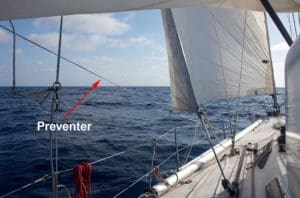
Preventer: The preventer holds the boom out in opposition to the mainsheet. It should place as little downward force on the boom as possible. Attach the preventer at the outboard end of the boom (not at the vang attachment point), lead it forward to a block set on the toe rail as far forward as possible, and then back to a winch in the cockpit convenient to the mainsheet winch. The preventer and mainsheet are worked in tandem — if you ease the mainsheet you bring in the preventer.
There are two schools of thought on rigging a preventer – using a fusible link of light cord that will break before the boom breaks or going strong to let the boom break before it can accidentally jibe. I’m in the latter group — if the boom is going to jibe it can strike and kill me, and there’s no chance I value the boom more than my skull. No fusible link in the system on my boat.
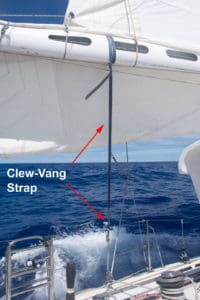
Clew-vang strap: The clew-vang strap runs from the boom to the toe rail, attached at the boom near the clew attachment point. The line requires adjustment and will see a lot of load. I send it through a block and then to a winch. The strap’s purpose is to capture upward shock load from the mainsail and transfer that load to the deck. This significantly reduces loads at the vang and gooseneck. Ideally the clew-vang strap can be moved along the boom and placed near the clew as you reef the mainsail or adjust the mainsheet. I use a webbing strap looped around the boom, with the loop loose enough to be shifted along the boom as needed. I attach a line to the strap and lead that line through a block on the deck and back to a winch. After adjusting the boom’s position, I can shift the block fore and aft along the deck to keep the block below the boom.
Trimming the mainsail downwind: With wind aft and the boat trundling along deep in the trades there’s little lift due to the sail’s camber. Make the mainsail as full as possible — ease the halyard, ease the outhaul. Set the mainsail square to the wind by easing the mainsheet and sending the boom out as far as possible without hitting the leeward shrouds. Bring the vang down hard to hold the boom horizontal and tension the leech. Tension the topping lift to support the boom against the vang. If you’re flying downwind twin headsails reefing the main can help with airflow onto the leeward headsail. The mainsail will likely be riding up against the shrouds, that’s fine. The sail might benefit from additional chafe patches where the battens press against the shrouds — something to talk with your sailmaker about before your trip.
If prevailing conditions cause the boat to roll, repeatedly inverting the mainsail, that’s when I have to decide: do I want to I alter course or bring on the clew-vang strap? If I want to remain on the same course I slide the strap close to the clew, run the line down through a snatch block on the deck, and back to a winch. I tighten that line enough to stop the boom from lifting each time the main flops and I’m in business. The preventer stops accidental jibes, and the shock loads are transferred to the deck, relieving forces on the boom, vang, and gooseneck. The risk of breaking the boom is significantly reduced. It’s great for the night running downwind under twin headsails. ν
Rob MacFarlane has singlehandedly raced and cruised for 30 years on San Francisco Bay, the West Coast, to Hawaii, Mexico, Canada and French Polynesia. He sails the 1983 Morgan N/M 456 IOR two tonner, Tiger Beetle.

